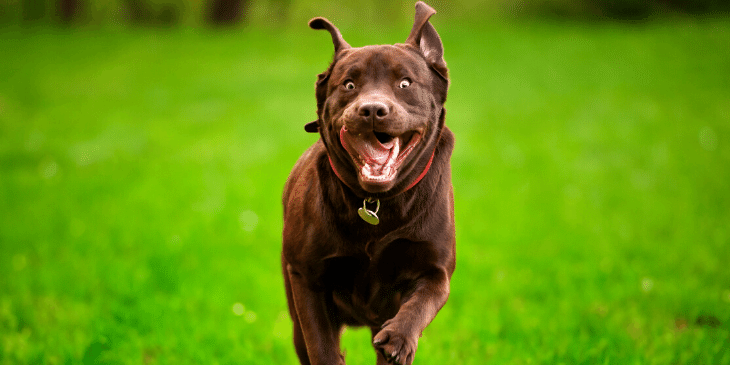What to Do If Your Dog Runs Out the Door

Contents
It can happen so fast. Your dog runs out the door and makes a mad dash toward the busy street with the entire family in frantic pursuit. To your dog, an open front door is an invitation to run and explore, and when everyone chases after him, the game becomes even more fun!
But for dog owners, this scenario is terrifying… what if he gets hit by a car? Or, you can’t catch him and he gets lost? Bolting out the door is a dog behavior that needs to be corrected quickly, but how do you do it?
Don’t worry! We have some dog training tips you can use to train your dog that running out the door is not allowed, and it’s something you can start teaching him right away. If your dog needs to learn to stay when the front door is open, the guidelines below will help you put a stop to door dashing and keep your pooch safe!
What To Do If Your Dog Runs Out the Door When Someone Opens It
Wondering what to do if your dog runs out the door when someone opens it? If your pup doesn’t already know basic obedience, you’ll need to start by teaching him the sit and stay commands. Before you begin teaching your dog not to run out the door, it’s important that he knows how to sit and stay without moving for about 20-30 seconds.
After he learns this essential command, you can start working on teaching him not to run out the door. When you’re first starting out, work in the back yard or a room where there aren’t too many distractions.
Teaching the Sit-Stay Command
Training dogs to sit isn’t as difficult as you might think. Start by holding a treat close to your pup’s nose. Once you’ve got his attention, move your hand up, causing him to follow the treat with his nose while his bottom lowers to the ground. Once he’s in the sit position, say “sit” and give him the treat. Practice this routine several times a day until he’s got it down pat.
Once he masters the sit command, it’s time to teach him to stay. Start by asking him to sit, then hold your open hand in front of you and tell him to stay. Take a couple of steps back. If he stays, reward him with a treat, even if it’s just for a few seconds.
As he begins to master the skill, you can gradually increase the number of steps you take and the length of time you expect him to stay. Keep in mind that stay can be a bit more challenging to master, especially for puppies and high energy dogs. Consistency and daily practice are the keys to success.
Teaching the Stay Command at the Front Door
Now that your dog has mastered sit and stay, it’s time to put a stop to your little escape artist’s door dashing. You’ll need a 30-foot long line and a properly fitted collar to get started. Harnesses are not optimal for training because they encourage the dog to pull and don’t provide enough control. Do not use the leash you put on him when you’re leaving the house or going for walks!
You’re going to need something to tether him to that’s near your front door, such as a railing, doorknob, or the leg of a sturdy table. This ensures that your pooch stays safe during the training exercise.
- Once your dog is securely tethered by the front door, start the exercise by practicing the sit and stay command with the door closed. Put your hand on the doorknob but don’t open the door. If he holds the stay position when you touch the doorknob, give him a treat and praise, even if it’s just for a few seconds. He should be on the long line during this entire process, and you’ll want to keep practicing until he is able to hold the stay position for at least 20-30 seconds. This process desensitizes your dog and reconditions his automatic reaction to run out the open door. Do not move on to the next step until he has this one mastered.
- Ensure that your dog is securely tethered with the long line. In this step, you’re going to practice the sit and stay command with the door open. Practice the same way you did in step one, but open the door a few inches each time. Slowly increase the amount of time you ask him to sit and stay and gradually open the door wider and wider as you practice. Once he has worked up to sitting with the door all the way open for 20-30 seconds, you’re ready to move on to the next step.
- Now you’re going to teach your dog to sit and stay while you open the front door and take a step outside. Start by stepping just outside the door for a few seconds. Gradually build up the time and distance as he masters the skill. Practice until you can walk five or even ten steps away and can even step around the corner out of sight. Whenever he comes out of the stay position, take him back to the starting position and begin again by going back just a few steps and working your way up. Keep practicing until you’re confident that he will hold the stay position for a reasonable amount of time, even if you step away from the door.
Teach Him That His Walking Leash is the Key to Going Out the Door
After he masters the steps above, you also want to teach your dog that his walking leash is the key to going out the door. He needs to learn that he’s not to step out the door without his leash on.
To accomplish this, tether him to his long line at the front door and ask him to sit. Attach his walking leash to his harness and then disconnect the long line while he’s still sitting, open the door, and then calmly walk him out. Reward him with treats and affection when he gets it right. If he tries to run out the door before your ready, return to the starting position and begin again, but don’t scold or discipline him.
Repeat this exercise until he learns to automatically sit and stay when the door is opened and not to go out until you put his walking leash on and tell him it’s ok.
Some Additional Dog Training Tips
- Don’t take chances! When your dog isn’t on a leash, use a baby gate or a crate to make sure your dog can’t run out an open door while you’re training him. Putting a GPS tracker on him may also be a good idea until you correct the behavior.
- Teaching your dog not to run out the door is extremely important, but your dog should have rules and boundaries in other parts of his life, too. Crate training is important, and so are other basic obedience commands like coming when called. Dogs who have boundaries and consistency are happier and more well behaved than dogs who don’t have clear rules to follow.
- As you’re practicing these steps, it’s important to remember that this is a practice in self-discipline for your dog. When he seems to be losing his patience and concentration, take a time out and come back to it later.
- Remember to use positive reinforcement through treats and affection. Do not discipline him if he messes up. Simply start over and keep practicing. Practice makes perfect!
- Once he has mastered the skills with you, have other family members practice with him, too. It’s crucial that he learns to respect rules and boundaries with everyone in the home.
- Never encourage your dog to go out the door when he’s off-leash, even after he’s trained, or you might undo all your hard work.
- Keep in mind that a bored dog who doesn’t get enough exercise is much more likely to develop bad behaviors like running out the door. Providing long daily walks for exercise and interactive dog toys for mental stimulation is every bit as important as proper training.
Final Thoughts
When your dog escapes through an open door, it’s extremely scary. Correcting this dog behavior quickly is crucial for your dog’s safety. If you’ve done your best but still can’t keep your dog from running out the door on your own, don’t hesitate to call in a dog trainer for advice.
